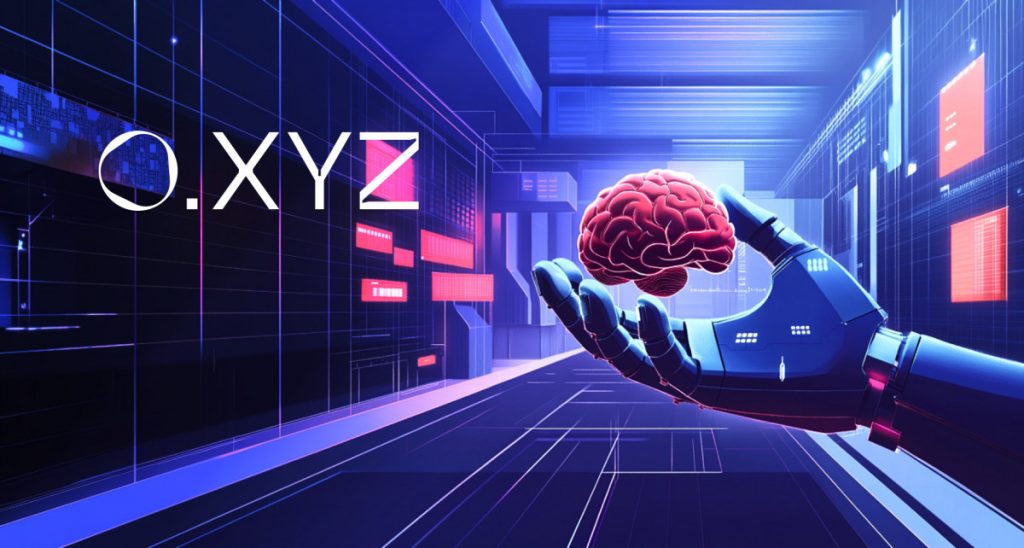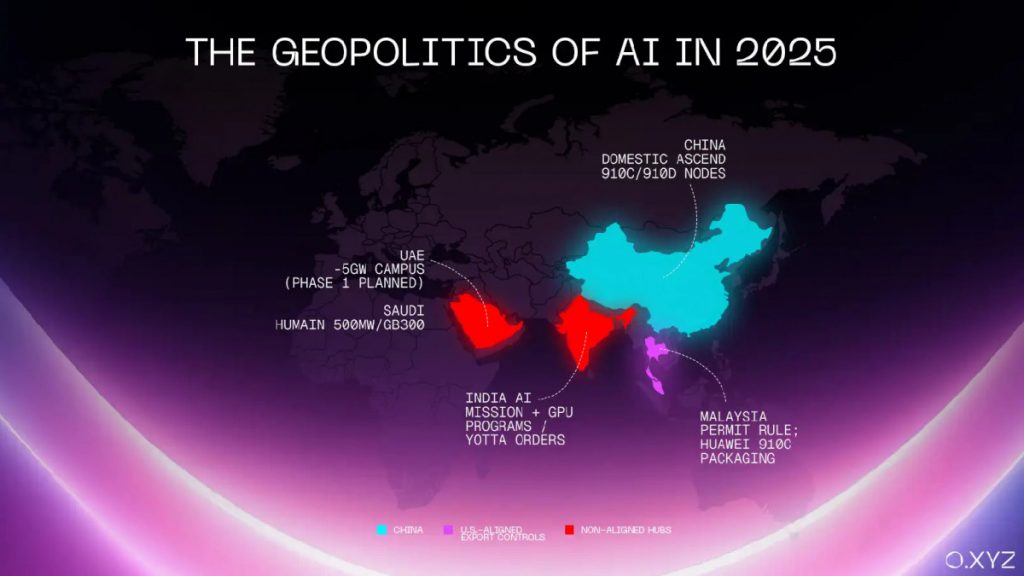O.XYZ Releases ‘AI Infrastructure 2025 Field Guide’: Building For Scarcity And Ensuring Verification


In Brief
O.XYZ’s new report highlights how geopolitical shifts, resource scarcity, and regulatory changes are reshaping the AI and Web3 landscape, with power and network infrastructure becoming the new bottlenecks.

Decentralized AI research and development organization O.XYZ, which is focused on building O, a sovereign superintelligence, has unveiled a report titled “The AI–Web3 Power Play 2025: How Global Power Splits and Infrastructure Crises Impact Web3.”
This report examines the geopolitical shifts within AI supply chains, the increasing scarcity of power and network capacity, and the pressures these developments place on decentralized technologies.
The analysis is based on a range of sources, including shipment data, court filings, cloud-pricing dashboards, and interviews with industry experts across five continents. The report argues that the global AI landscape has now been divided into three competing spheres of influence. It highlights that, as of 2025, the primary bottlenecks in AI development have shifted from hardware, such as silicon, to critical resources like electricity, cooling, and fiber.
The report details how Malaysia’s stricter export controls on US-made accelerators have deepened the divide between the US and China, coinciding with China’s efforts to ramp up production of Huawei’s Ascend 910C and the CloudMatrix cluster.
Additionally, the report points to the rise of a new alliance between the UAE, Saudi Arabia, and India, which is financing the development of large-scale sovereign computing capabilities, establishing a third power center that is not fully aligned with either Washington or Beijing. Despite a reduction in the spot prices for Nvidia H-class chips since early 2024, the report notes that deployment schedules and costs are increasingly dictated by grid interconnect delays, transformer shortages, and internal throttling measures, such as Amazon’s “Project Greenland.”
“Compute has become a geopolitical asset,” says Ahmad Shadid, Founder & CEO of O.XYZ. “Web3 projects that ignore the new geography of chips, power, and law will find themselves yoked to centralized gateways. Survivors will be those who plan for scarcity, verify hardware and content, and diversify across jurisdictions,” he added.

Cloud GPU Pricing Disparities And Rising Talent Competition Drive Shifts In AI Landscape
Cloud GPU pricing continues to exhibit variation. Public pricing for Google’s A3 instances, along with the anticipated mid-2025 price cuts from AWS, highlight regional discrepancies that can be as wide as six-to-one. Additionally, marketplace discounts and private offer rebates further complicate the transparency of actual costs. Concurrently, competition for skilled talent has intensified dramatically, with companies like Meta and various leading research labs offering compensation packages nearing one hundred million dollars. This trend is contributing to higher turnover rates among researchers and reducing the talent pool available to open-source communities.
At the same time, regulatory frameworks are increasingly focusing on provenance and attestation. The European Union’s General-Purpose-AI regulations, which partially came into effect on August 2nd, 2025, now mandate the tracking of model lineage, risk documentation, and content credentials for many AI products. Similarly, in the United States, the bipartisan Chip Security Act, along with White House guidelines, now require the verification of the location and chain-of-custody records for advanced AI processors, effectively placing the responsibility for hardware provenance on all serious AI developers.
Ahmad Shadid Shares Insights On Web3 Adaptation To AI Dominance And Offers Practical Solutions For Overcoming Compute Challenges
In a commentary to Mpost, Ahmad Shadid, CEO of O.XYZ, discussed the widening gap between the innovation driven by AI hyperscalers and the resource limitations facing Web3. He explained that while this divide presents challenges for decentralization, it does not make it unachievable.
“Hyperscalers control scarce resources like GPUs, power, and grid interconnects, allowing them to prioritize their own demand and selectively lower prices, which pulls projects toward their stacks. At the same time, internal rationing programs like Amazon’s ‘Project Greenland’ demonstrate how capacity is centrally allocated, further reinforcing their advantage,” said Ahmad Shadid to Mpost. “For Web3 teams that cannot secure stable compute, relying on centralized APIs becomes the default, undermining credible neutrality. The long-term viability of decentralized projects will depend on designing for scarcity and provability (attestation, provenance) so they can function across mixed infrastructures, not just hyperscalers,” he added.
Sharing practical solutions and strategies for Web3 builders to navigate the high cost of AI compute and remain competitive in an increasingly AI-centric landscape, Ahmad Shadid offered several pieces of advice.
He first recommended optimizing for cost by using smaller or quantized models, or Mixture-of-Experts models, and taking advantage of price differences across regions and providers, as the spreads between clouds and programs are important. The expert then suggested adopting a multi-rail approach to compute, combining centralized clouds with decentralized GPU markets where service-level agreements (SLAs) align, noting that independent research shows DePIN networks like Akash offer lower hourly rates and a growing inventory of high-end GPUs. Ahmad Shadid also emphasized the importance of building verifiability into the system by utilizing GPU/TEE remote attestation, such as NVIDIA NRAS or Intel Trust Authority for H100, to ensure that counterparties can trust results, regardless of where workloads run. Lastly, he recommended hedging power risk by deploying across multiple jurisdictions and providers, as grid constraints and demand-response agreements can throttle capacity at short notice.
Outlining further perspectives, Ahmad Shadid expressed the expectation that Web3 protocols will eventually adjust to the increasing dominance of AI, while centralized AI infrastructure is likely to remain the prevailing force, overshadowing decentralized technologies in the foreseeable future.
“AI’s centralized infrastructure will maintain outsized influence because power, land, and capex favor hyperscalers, and enforcement trends (such as EU GPAI obligations and U.S. location-verification/anti-smuggling measures) introduce compliance overhead that large providers can absorb. However, Web3 protocols that adapt by proving where and how models run, diversifying compute, and treating provenance as mandatory, can coexist and even offer the trust and portability layers that centralized AI currently lacks. Over time, the winners in Web3 will be those that make ‘attested, portable AI’ a feature, not an aspiration,” the expert concluded.
Disclaimer
In line with the Trust Project guidelines, please note that the information provided on this page is not intended to be and should not be interpreted as legal, tax, investment, financial, or any other form of advice. It is important to only invest what you can afford to lose and to seek independent financial advice if you have any doubts. For further information, we suggest referring to the terms and conditions as well as the help and support pages provided by the issuer or advertiser. MetaversePost is committed to accurate, unbiased reporting, but market conditions are subject to change without notice.
About The Author
Alisa, a dedicated journalist at the MPost, specializes in cryptocurrency, zero-knowledge proofs, investments, and the expansive realm of Web3. With a keen eye for emerging trends and technologies, she delivers comprehensive coverage to inform and engage readers in the ever-evolving landscape of digital finance.
More articles

Alisa, a dedicated journalist at the MPost, specializes in cryptocurrency, zero-knowledge proofs, investments, and the expansive realm of Web3. With a keen eye for emerging trends and technologies, she delivers comprehensive coverage to inform and engage readers in the ever-evolving landscape of digital finance.


















































